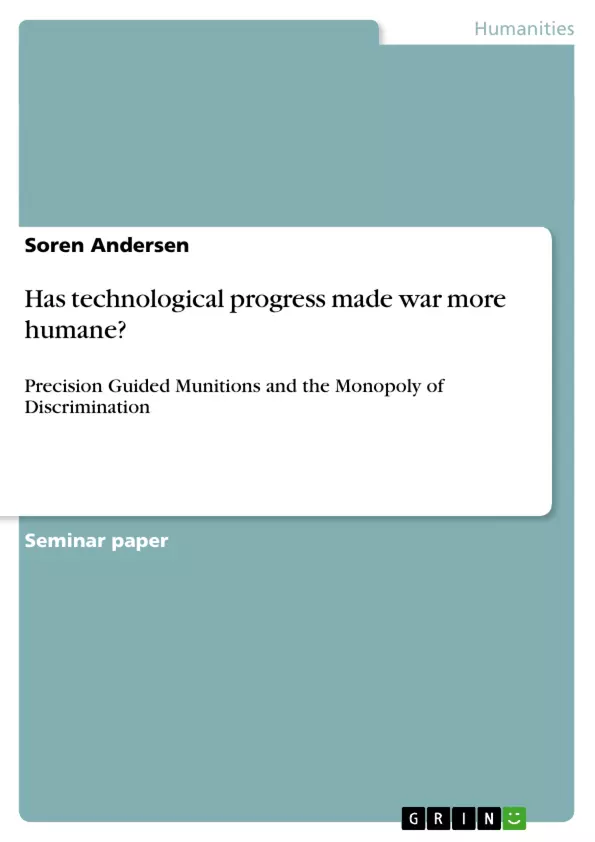The following paper will examine one of the more recently militarily implemented technological advances, namely precision guided munitions (PGMs), which have become an integral part of the strategy of today’s undisputed technological forerunner in military hardware, the U.S. Armed Forces. This technology uses both high-end military technology as well as civilian technology, such as the Global Positioning System (GPS) to navigate by. One of the aims of this paper is to show how these changes in technology is an indicator of a more humane focus on “our” soldier, i.e. a decreasing willingness to put these soldiers’ life on the line. It will be argued that the use of such weaponry as PGMs, seemingly, in a techno-fetishist way, has made war more humane, but that the rhetoric surrounding them also has had the effect of privileging the wielders of these in a highly asymmetrical way.
Inhaltsverzeichnis (Table of Contents)
- Technology and war
- What revolution? The image of the costless war
- The myth of the surgical strike – has PGMs made war (seem) more humane?
- Who has the power to discriminate? Privileging actors through access to PGMs
- What is enabling the PGMs? Neutralization of the distinction between civilians and military targets
- Monopolists of War. How PGMs promote increased warfare
- Conclusion
Zielsetzung und Themenschwerpunkte (Objectives and Key Themes)
This paper examines the impact of precision-guided munitions (PGMs) on the conduct of warfare, particularly in terms of their perceived humanizing effect. It explores the role of technology in shaping military strategy and its impact on the distinction between civilian and military targets.- Technological advances in warfare and their implications for humanizing conflict
- The role of PGMs in shaping military strategy and their impact on the nature of warfare
- The discourse surrounding PGMs and the potential for a "techno-fetishistic" approach to warfare
- The implications of PGMs for the discrimination between combatants and non-combatants
- The influence of PGMs on the power dynamics of warfare and the privileging of certain actors
Zusammenfassung der Kapitel (Chapter Summaries)
- Technology and war: This chapter introduces the complex relationship between technological progress and warfare, arguing that the lines between civilian and military technology have blurred in the modern era. It sets the stage for the discussion of PGMs by highlighting the ongoing debate about the impact of technology on the humanization of war.
- What revolution? The image of the costless war: This chapter delves into the concept of a "Revolution in Military Affairs" (RMA), focusing on the 1991 Gulf War as a prime example. It examines the rhetoric surrounding PGMs, arguing that the promise of pinpoint accuracy and reduced civilian casualties has led to the idea of a "costless" war. The chapter further critiques this perception, highlighting the potential for a techno-fetishistic approach to warfare.
- The myth of the surgical strike – has PGMs made war (seem) more humane?: This chapter critiques the notion of PGMs as inherently discriminatory weapons. It argues that while PGMs offer greater precision than traditional weapons, the information used to target them can be flawed. This raises questions about the effectiveness of PGMs in distinguishing between combatants and non-combatants, ultimately challenging their claim of contributing to a more humane approach to warfare.
- Who has the power to discriminate? Privileging actors through access to PGMs: This chapter explores the power dynamics associated with PGMs, suggesting that their use may further entrench existing power imbalances. The chapter emphasizes that the technology itself is not inherently discriminatory but rather reflects the biases of those who control it. It warns against the potential for PGMs to exacerbate existing inequalities and reinforce the power of certain actors in the global sphere.
Schlüsselwörter (Keywords)
This paper focuses on the relationship between technological advancements, particularly the development of precision-guided munitions (PGMs), and the humanization of war. It examines the concept of "Revolution in Military Affairs" (RMA), the rhetoric surrounding PGMs, the issue of discrimination between combatants and non-combatants, and the potential for a techno-fetishistic approach to warfare. The paper also explores the impact of PGMs on power dynamics and the privileging of certain actors in international conflicts.- Quote paper
- Soren Andersen (Author), 2009, Has technological progress made war more humane?, Munich, GRIN Verlag, https://www.hausarbeiten.de/document/146959


